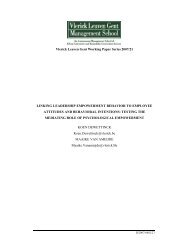innovation and internationalization by indian firms - Vlerick Public
innovation and internationalization by indian firms - Vlerick Public
innovation and internationalization by indian firms - Vlerick Public
You also want an ePaper? Increase the reach of your titles
YUMPU automatically turns print PDFs into web optimized ePapers that Google loves.
INNOVATION AND INTERNATIONALIZATION BY INDIAN FIRMS: THE EVOLUTIONARY<br />
PATH SINCE 1990.<br />
Innovation <strong>by</strong> Indian <strong>firms</strong> has been driven <strong>and</strong> determined <strong>by</strong> a mix of institutional, industry<br />
<strong>and</strong> firm-level factors. As the economic <strong>and</strong> institutional environment has evolved, the competitive<br />
dynamics across a range of industries have changed. Specifically, the emphasis that <strong>firms</strong> have<br />
placed on <strong>innovation</strong> versus <strong>internationalization</strong>, <strong>and</strong> the nature of the relationship between the<br />
two, has changed over time. While there have been distinct cases of companies using India-specific<br />
factors to compete in international markets, such as the well-known <strong>and</strong> widely recognized success<br />
of Indian IT <strong>and</strong> BPO <strong>firms</strong>, there have been an equal number of cases driven <strong>by</strong> other types of<br />
relationships between <strong>innovation</strong> <strong>and</strong> <strong>internationalization</strong> which we outline below.<br />
To structure our analysis, we look at three distinct though overlapping phases of <strong>innovation</strong><br />
<strong>and</strong> <strong>internationalization</strong> of Indian <strong>firms</strong>.<br />
Phase One (1990-2000): Arbitrage-based Internationalization<br />
The first phase of Indian <strong>internationalization</strong>, roughly corresponding to the 1990s, marks a<br />
starting point in terms of the development of the <strong>innovation</strong> capabilities of Indian MNEs. The overall<br />
thrust of such <strong>innovation</strong> involved the arbitrage of a low-cost base in India. The penetration of<br />
international markets was based on trading of entrepreneurial skills. Such <strong>internationalization</strong> was<br />
largely focused on markets that at the time were categorized as transitional or developing – such as<br />
the ex-Soviet bloc, Africa <strong>and</strong> South East Asia. To gain a better underst<strong>and</strong>ing of why this was the<br />
preferred method of <strong>internationalization</strong>, we examine the context, both in India <strong>and</strong> overseas, <strong>and</strong><br />
the type of firm-level <strong>innovation</strong> that leveraged this context.<br />
The Indian context, in the 1990s, consisted of groups of largely oligopolistic <strong>firms</strong>,<br />
particularly family-owned business groups, across a range of industries. Such an outcome was due to<br />
a specific approach to a managed market economy that the Indian government had pursued for the<br />
preceding decades. Specifically: the government allocated licenses to <strong>firms</strong> to undertake a specific<br />
industrial activity, <strong>and</strong> the focus of government policy was a) import substitution across a range of<br />
products, such as consumer goods <strong>and</strong> medicines <strong>and</strong> b) to manage ‘destructive’ competitive forces<br />
(Luce, 2008).<br />
At the same time, a large number of industry sectors had also been ‘reserved’ for small <strong>and</strong><br />
medium sized enterprises – this was termed as the ‘license raj’, wherein the state was involved in<br />
micro-managing the management decisions of private <strong>firms</strong> (Das, 2002; Luce, 2008). The 1990s<br />
marked a period when new institutional arrangements were being devised <strong>and</strong> slowly implemented.<br />
4










